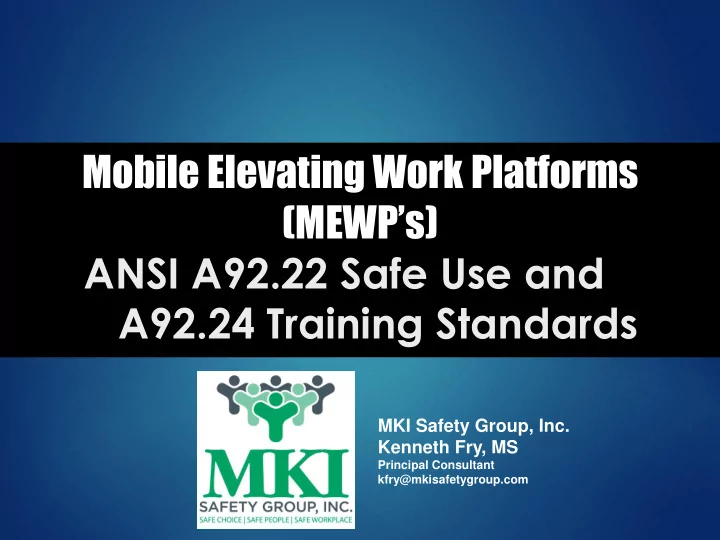

Mobile Elevating Work Platforms (MEWP’s) ANSI A92.22 Safe Use and A92.24 Training Standards MKI Safety Group, Inc. Kenneth Fry, MS Principal Consultant kfry@mkisafetygroup.com
Objectives Prevent employee accidents (electrocutions, falls, tip-overs) and property damage Establish application, inspection, training, maintenance, repair and safe operation requirements Establish and provide an understanding of responsibilities Promote the safe use of the MEWP’s
American National Standard Institute (ANSI) A92.20-Design A92.22-Safe Use A92.24-Training Standards Address the design of new aerial lift equipment and the training operators, supervisors and maintenance workers must complete.
American National Standard Institute (ANSI) Effective December 2019 Both new and existing units delivered by sale, lease and rental on or after the effective date. ANSI A92 will not require retroactive changes.
New Standards Training and compliance terminology (Aerial Lifts are now Mobile Elevating Work Platforms) Equipment Classification (Group A and B with Types 1, 2, & 3) Safe Use Program Risk Assessment (include Rescue Planning) Training for Occupants and Supervisors Training Documentation
New Standards The new standard shall be used in conjunction with: Manufacturer’s make and model operator’s manual. SAIA Manual of Responsibilities for the Safe Use of Mobile Elevating Work Platforms. Manuals shall be stored in the weather-resistant compartment on the MEWP.
MEWP Classifications (Groups) (Group A)-MEWPs with platform such as scissor lifts that move vertically but stay inside the tipping lines. (Group B)-MEWPs such as boom-type MEWPs move beyond the tipping line (chassis). Image Credit: JLG
MEWP Classifications (Types) (Type 1 MEWPs)-Traveling is allowed only when in the stowed position. (Type 2 MEWPs)-Traveling with the work platform elevated but controlled from a point on the chassis. (Type 3 MEWPs)-Traveling with the work platform elevated but controlled from a point in the work platform. Image Credit: JLG
Additional Changes (A92.20-1918 Design) Will require new aerial lifts to be equipped with two types of sensors. One sounds an alarm and prevents the machine from operating when • the safe load limits are exceeded. The other is a tilt sensor. It triggers an alarm and prevents movement of • the chassis or work platform when a certain level of slope is exceeded.
Additional Changes (A92.20-1918 Design) Other equipment changes include: Can no longer use chains to close off entrances to the work platform. Instead, they must use gates that include toe guards. MEWP platform railings must be at least 43.5 inches in height. The old standard was 39 inches. MEWPs used on rough terrain must be outfitted with solid or foam-filled tires rather than air-filled tires. This will improve the stability of the MEWP.
New Standards Written Safe Use Plan Specific to MEWPs shall be developed and include: Detailed site risk assessment to identify hazards, evaluate risk, develop • control measures and communicate with affected persons; Selection and use of the MEWP’s; • Worksite inspections and preparation; • Trained and qualified supervisor(s) to monitor operator work performance • and compliance with the new standards; Only trained and authorized personnel to operate and/or occupy the • MEWP; Rescue plans that everyone understands; • Retention of required documentation; and • Maintenance including inspection(s) and repairs as required by this • standard and manufacturer specifications.
Site Risk Assessment Identify Task to be Undertaken Select Appropriate MEWP Assess Associated Risks Identify Control Measure Identify Safe Work Practices (includes Rescue Plan) Communicate the results Image Credit: JLG
Rescue Plan Implement prior to start of work Must be in written format Made part of the training manual Carried out by appropriately trained personnel
Rescue Plan Rescue Plan can include: Self-Rescue (by person involved) Assisted Rescue (by others in the work area) Technical Rescue (by emergency services)
Rescue Plan Sample Situations that a rescue plan must include: Complete equipment malfunction Work platform entanglement After a fall
Supervisor Training All personnel who directly supervise MEWP operators must be trained in the following areas: Selection of the right MEWP for the work to be performed; • The rules, regulations and standards for safe MEWP operation of the • work being performed; Potential hazards related to the use of MEWPs; • How to protect against those hazards; and • Ensuring the operating manual is stored in a weather-resistant • compartment on the MEWP.
Occupant Training Fall protection use requirements and location of anchor points; Factors that could affect stability; Safe us of MEWP accessories they are assigned to use; Site-specific work procedures related to the MEWP operations; Review of the site risk assessment for tasks to be completed; General knowledge of the intended purpose and function of MEWP controls; and Manufacturer’s warnings and instructions.
Other new training requirements include: Site- and equipment-specific rescue plan. • Operator familiarization prior to operating a type of MEWP. • Operators must explain to other workers on the lift how to get down • if something happens to the operator. At least one person who can operate the equipment from the • ground if the crew can’t lower themselves. Maintenance workers must be trained on all new features, such as the tilt and load sensors.
WHERE WE ARE TODAY?
Questions?
Saf Safety ety Lead Leading Indic ing Indicator tors Leading Indicators Safety training (new hire orientation and on-going) • Participation in safety training and safety meetings • Safety inspection execution and results • Ergonomic opportunities identified and corrected • Safety observations • Employee perception surveys •
Recommend
More recommend